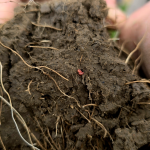Silt Recovery Taskforce update
Huge silt recovery project underway. Could require removing 5-6 million cubic metres of silt, out of 12 million deposited.
Added 3 years ago
By Brenda Newth

We caught up with taskforce lead Darren de Klerk for an update on progress.
To say we’re busy is an understatement, says de Klerk.
“Currently there are around 320 jobs logged in the system to be dealt with. We estimate that the volumes on those jobs at around one million cubic metres,” he explains.
“With an estimated 4,000 hectares of productive Hawke’s Bay land affected by silt it is going to take a very long time to deal with it.”
The taskforce is waiting on NIWA’s estimate of silt that has been deposited across the land, but de Klerk reckons if you allowed for 300mm of silt across the 4,000 hectares that would amount to roughly 12 million cubic metres.
“So if we removed about half of it, that’s five or six million cubic metres.”
Currently there’s around 800-900 truck movements daily carting silt, at around eight cubic metres per load. At that rate, it would take nearly 700 days to move five million cubic metres. de Klerk says the timeframe will be determined by how much silt is moved.
“The initial rush is to get land as productive as possible; trying to salvage trees and production. Understanding what the land will be used for in the future will determine how much silt gets removed.
“Zoning may come into that as well, landowner preference, and considerations around overland flow paths and stormwater ponding.”
de Klerk says that the taskforce is trying to find permanent sites for the silt, to avoid double handling. “We don’t want to have to shift it in the long run. There are some sites that are temporary, but now we are out of the initial heat of the battle, we’re looking for sites that can be permanent.”
Landowners that want to offer their property as a silt site, can get in touch with the taskforce on 0800 108 838, or from 1 May email: hdcsilt@hdc.govt.nz.
What makes for a good silt deposit site? de Klerk says all potential sites are evaluated for suitability.
“Will it be problematic to consent in the long run? Does it have significant natural areas? Might we make flooding worse? We need to take consideration of waterways, think about neighbours, making sure the site isn’t too far away from where the silt is being collected.
“Part of the assessment considers the district plan and the regional management plan.”
So far some of the silt collected is being used by a quarry to produce basecourse that is going into roading material, and some is being used for composting.
The biggest challenge to the silt recovery taskforce completing its work is the funding, he says.
“The funding is still to be sorted. The taskforce is working with central government for funding. But how it stands at the moment, funding is still an unknown. We’re hoping to get an answer on that very soon.”
de Klerk says he is out in the field meeting with landowners and talking to contractors who are doing the work.
“People are pretty overwhelmed, struggling and grappling with what they do next. We acknowledge that people are going through some very tough times. It’s our role as leaders to try and help them as much as possible, but we’ve also got a pretty significant workload ahead of us.”
Key learnings from Silt Recovery Taskforce (so far):
- Need for adequate resource
- Preference for permanent silt sites
- Split the Bay into zones, and assigning contractors
- Establish a triage or assessment process
- How to manage/deal with silt that has products/items in it
The taskforce will soon be publishing a regular newsletter, and invites people to subscribe through the silt email address: hdcsilt@hdc.govt.nz
Join the conversation
Te nahu roading - May 5, 2023, 10:51 PM
It's a mess
Leave a comment
All comments are reviewed before they are published on the website. Your email address will not be published.



Community Engagement and Knowledge Sharing Strengthen the Carbon Positive Project


Farewell to Trustee Phil Schofield – A Foundational Leader of the HBFFCT

